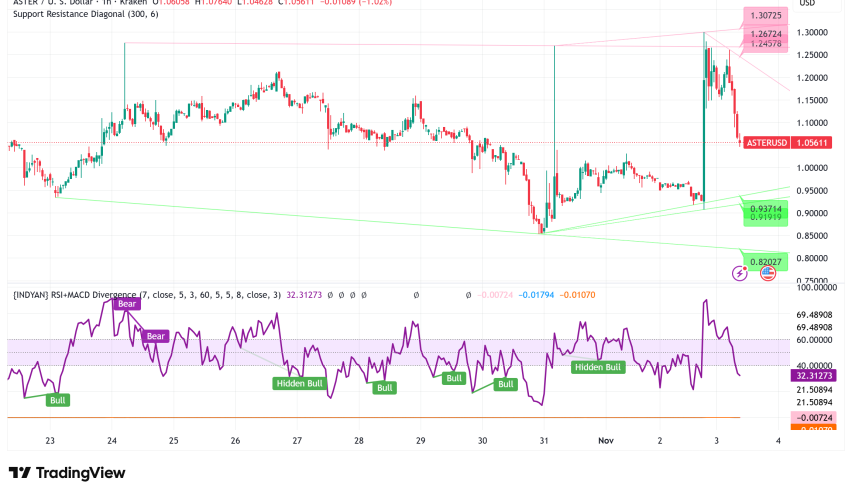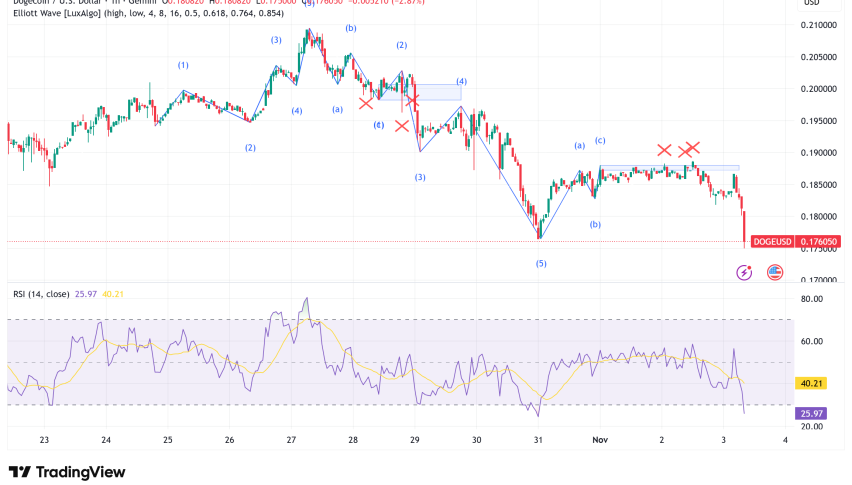Bitcoin Consolidates Above $109K as Distribution Phase Tests Market Structure
Bitcoin is still trading over the psychologically crucial $109,000 mark. This is because it is the most popular cryptocurrency and is

Quick overview
- Bitcoin is currently trading above $109,000, with a stable price around $109,600 amidst fluctuating market conditions.
- Despite recent price stagnation, Bitcoin's realized cap has surged by over $8 billion, indicating ongoing demand primarily from treasury businesses and ETFs.
- Long-term holders have sold approximately 400,000 BTC in the last month, but this selling pressure is seen as profit-taking rather than a mass exodus.
- Analysts predict Bitcoin could reach $140,000 in November, driven by potential Federal Reserve rate cuts and increased ETF inflows, although risks remain.
Bitcoin BTC/USD is still trading over the psychologically crucial $109,000 mark. This is because it is the most popular cryptocurrency and is dealing with a complicated market that has strong on-chain fundamentals but weak institutional momentum.
As of this writing, BTC is holding stable at about $109,600, with just small fluctuations in the last 24 hours. Market participants are intently watching important support and resistance levels that will likely define the direction of the price action in November.

Realized Cap Surge Signals Underlying Demand Despite Surface-Level Stagnation
Bitcoin’s on-chain data show that people are still buying it, even if the price has been stable recently. The network’s realized cap, which shows how much all the coins are worth in dollars at their last moving price, has gone up by more than $8 billion in the past week, bringing the total to more than $1.1 trillion. This number has become highly important since Bitcoin’s realized price went above $110,000. It shows that real money is still coming into the ecosystem even though price discovery is still low.
Ki Young Ju, the CEO of CryptoQuant, says that these large inflows are mostly coming from Bitcoin treasury businesses and exchange-traded funds. These have become the main drivers of demand in the current market cycle. But Ju warns that Bitcoin’s price rebound will be limited until major institutional channels, especially spot ETFs and Michael Saylor’s Strategy, start their aggressive accumulation campaigns again. “Demand is mostly coming from ETFs and MicroStrategy right now, but both of these have been buying less lately,” Ju said. He also said that market momentum will probably only come back when these big purchasers come back into the market with a lot of money.
Long-Term Holders’ Distribution Strategy as BTC Mining Power Expands
On-chain analyst Burak Kesmeci has noticed a big change in the way Bitcoin’s long-term holders (LTHs) act. The Long-Term Holder Net Position Change metric shows that about 400,000 BTC were sold in the last 30 days. During bull market cycles, early adopters and patient investors start to make money after prices have been rising for a while. This is a standard pattern that happens during this distribution period.
But crypto expert Darkfost gives these distribution levels some vital context by pointing out that the 2.2% drop in LTH supply in October is still rather little compared to what has happened in the past. The amount of LTH available fell by about 5.05% in March 2024, and it fell by about 5.2% in December, which was much worse. This makes it look like the current selling pressure is more like early profit-taking than a mass exodus. This could lay the ground for more accumulating once distribution settles down.
Bitcoin miners are still increasing their operations, which is pushing the network’s hashrate to new highs. This is counteracting the selling pressure from long-term holders. CryptoQuant’s Ju calls this mining increase a “clear long-term bullish signal” for Bitcoin’s future growth. Major mining companies, including American Bitcoin, which is tied to the Trump family, have spent hundreds of millions of dollars on new mining equipment. This shows that they believe in Bitcoin’s long-term value proposition, even though the price is volatile in the short term.
BTC/USD Technical Levels: Define Critical Juncture
From a technical point of view, Bitcoin is at a few important levels that will probably decide whether the cryptocurrency can stay at its current high or falls again. The 21-week exponential moving average is currently at $111,230, which is a level of immediate resistance that bulls must break through to prove that the recovery after the correction is real. Rekt Capital, an analyst, says that getting back to this level would mean a successful post-breakout retest, which might lead to higher prices.
The $109,200 area has become a strong support level, with $107,696 and $104,582 acting as secondary cushions that get deeper as selling pressure rises. On the plus side, resistance goes up to $112,000 in the short term, and if momentum picks up, it may go as high as $115,600 or even $118,000.
Cas Abbe, an analyst at CryptoQuant, points out that the 38.2% Fibonacci retracement line, which is just around $100,000, is an important historical bottom forming zone. Bitcoin has continuously found support above this technical level since the first quarter of 2023. This suggests that the current consolidation over $100,000 may be a long-term floor rather than just a short-term break.
Bitcoin Price Prediction: $140K in November on Fed Easing and ETF Revival?
Even though the short-term view is cautious, analysts at the Bitfinex exchange say that Bitcoin might hit $140,000 in November if all goes well. Their base case model expects total ETF inflows to be between $10 billion and $15 billion. This is based on the possibility of Federal Reserve rate cuts in the fourth quarter and the fact that November and December are usually strong months for the market.
The Bitfinex analysts said, “Catalysts include Fed easing with two cuts in Q4, ETF inflows doubling, and seasonal Q4 strength, while risks remain around tariffs and geopolitics.” They saw both the potential for the market to go higher and the hazards that may cause it to go down.
Analysts pay a lot of attention to the November seasonality aspect because Bitcoin has made big gains in this month in the past, averaging 42.5% returns since 2013. The cryptocurrency hasn’t been able to keep its weekend gains going into the start of typical trading sessions lately, though. This signals that any big breakout will need institutional support rather than weekend pumps from retail investors.
- Check out our free forex signals
- Follow the top economic events on FX Leaders economic calendar
- Trade better, discover more Forex Trading Strategies
- Open a FREE Trading Account


